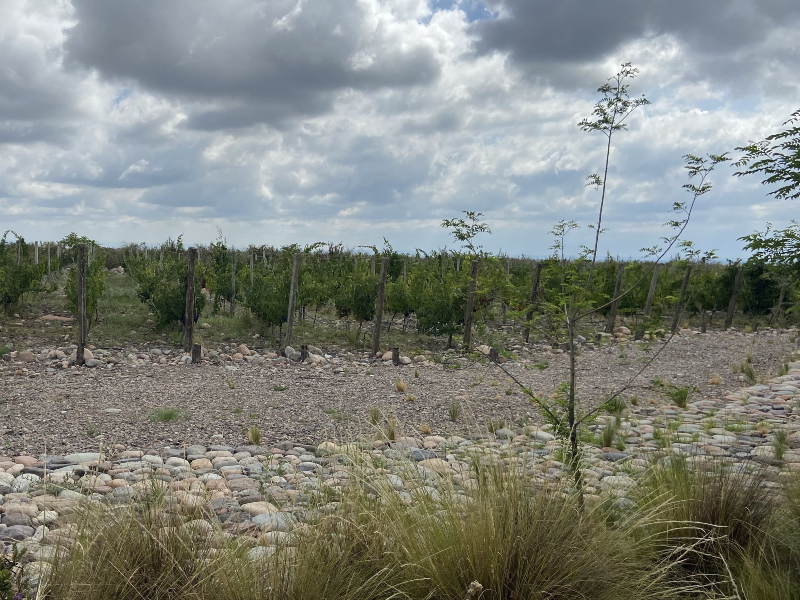In addition to being an important site in the history of Argentina, Los Chacayes has also been one of the country’s fastest expanding wine regions in recent times. The French winegrower Francois Lurton was a pioneer in the region: after spending four years in Mendoza, he bought land in 1996 and even patented the “Los Chacayes” name, using it on the label of the first wine he made from there before ceding it to the other producers in the area.
And so, Los Chacayes went from being an area devoid of vineyards to in just 20 years boasting 1900 hectares under vine, a development made possible by the implementation of drip irrigation, among other factors.
The Los Chacayes Geographic Indication

The Los Chacayes Geographic Indication (GI) was officially declared on 2017 by the National Institute of Viticulture (NIV). Involved in the work were the producers Luis Reginato and Eduardo Soler, among others. As in other cases, it was seen as essential to protecting and promoting the distinctive characteristics of Los Chacayes.
In 2022, the GI expanded to the east to include the area up to the Clodomiro Silva road, a process that required the taking of 150 soil samples to justify the expansion.
Although he wasn’t involved in the process or the relevant studies, the renowned geologist Guillermo Corona says that Los Chacayes “highlights the fascinating soil variations, which present great differences in the amount of sand, lime, carbonate and conglomerates they contain.”
That variability is defined by three alluvial fans: the northern fan, the southern fan and the fan in the eastern extension.
The first, which was where Los Chacayes was first planted in the main, has rocky, riverbed soils. The second has sandier soils with chalky pockets and the third is combination of the two.
Los Chacayes is very densely planted in its lowest sector and vineyards are slowly rising higher, almost all of them along the route that rises up to the Manzano Histórico, the historic apple tree where founding father General San Martin once rested.
The distinctive qualities of the vines
The aforementioned diversity and qualities give producers in Los Chacayes the opportunity to make wines with unique qualities that are difficult to replicate in other regions.
In that regard, Cristian Moor, the oenologist at Bodega Corazón del Sol and president of the Civil Association of Producers of the Los Chacayes GI, says that the “profile of the wines has two main aspects: distinctive tannins, which make their presence felt and need to be tamed, and spicy aromas and flavors that are due to the local flora and organic management of the vineyards.”
Meanwhile, Agustina Hanna, the oenologist at Ruca Malen, says that they chose the area because they were looking for wines “with different layers of aromas and textures,” something that Los Chacayes provided with one vineyard at about 3000 feet and another at 5300 feet above sea level, with different microclimates and soil types in between, making for “wines with wonderfully complex profiles.”
A diverse range of varieties

Mariana Onofri, the Wine Director at The Vines and owner of Onofri Wines, says “Los Chacayes has demonstrated exceptional ability to adapt to different varieties, more than just Malbec or Cabernet Franc.”
These include Mediterranean varieties such as Garnacha, Monastrell, Marsanne and Roussanne. Mariana says that all have adapted remarkably well, expressing different aspects of the terroir.
Onofri also highlights the potential of Italian varieties such as Teroldego and Negroamaro, which have “developed great personality in Los Chacayes, surprising me pleasantly with their unique profiles.”
Strength in togetherness
With 25 of 30 producers in the GI active members, the Civil Association was formed in 2019 in order to send a consistent message about the qualities of the terroir and to promote the quality wines that are made in the region.
In addition to the institutional mission of the Civil Association, Mariela Ilardo, Director of Solo Contigo Wines, believes that “teamwork is fundamental for improving how our employees are trained, accessibility to public transport and other essential aspects to the area’s development.”
Over the past few years, Los Chacayes has consolidated its place as a very important viticultural region in Argentina, not just because of its growth and expansion but also the quality and diversity of its wines.
The combination of a unique terroir, collaboration between producers and recognition of the GI, ensure a promising future for this fascinating region.



